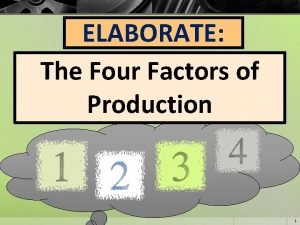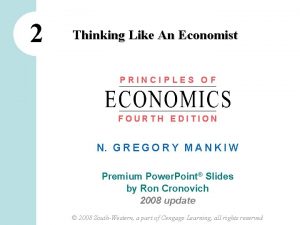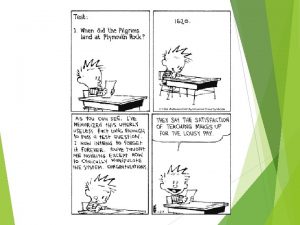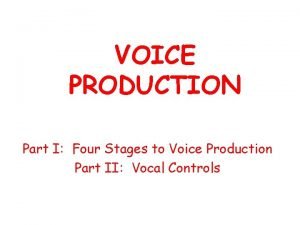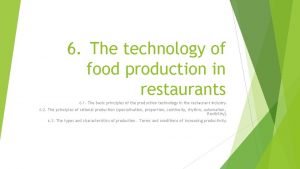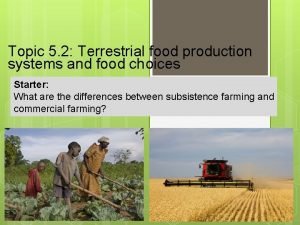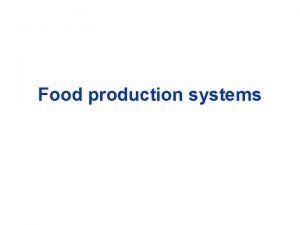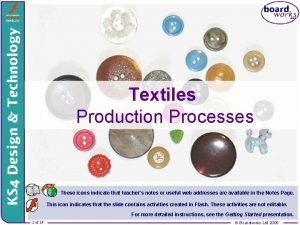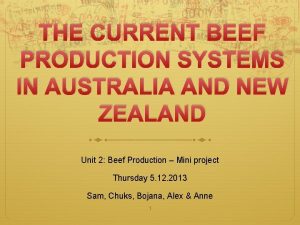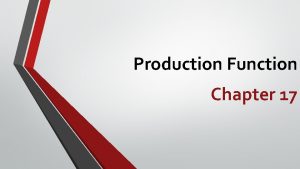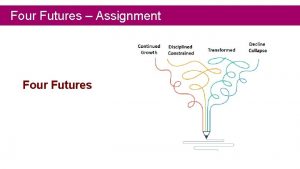Production Systems n n n There are four















- Slides: 15

Production Systems n n n There are four basic types of production system - each one can use a different type of machine and with different levels of automation. Which system is used depends generally on how many identical products are to be produced, and how continuous the production is to be. Jobbing- making a one-off product Batch - making a specific quantity of a product Mass-Produced - high volume production Continuous – non-stop production 24 hrs/day

Production Systems n 1. One-off or jobbing production is used to produce very small amounts or specialised products. This might mean producing a single piece of switch gear for a factory machine. Workers in this type of industry need to be highly skilled in a range of different areas and able to work on a number of aspects of the project. Examples include made—to-measure furniture and one-off buildings like the Millennium Dome. Luxury and customised products

Production Systems 2. Batch production is the most common type of production in industry. It involves making a set number of exactly the same product. Some batches will be small, others could be thousands. Batch production might be used to make PCBs for aircraft controls, for example, or control panels for central-heating boilers. Makes a group of identical products

Production Systems n 3. Mass or in-line production is used when very many identical products are required, such as cars, washing machines and fridges. The products are assembled as they flow along a production line. The operators tend to be semi-skilled. As well as expensive specialist equipment, a large work force is required. Production can be broken down to small repetitive task, therefore not necessary to employ skilled people. Cheaper Identical Products

Production Systems n 4. Continuous-flow production is where production is heavily automated and runs 24 hours per day. Continuousflow production is used in oil refining and chemical processing. A considerable amount of electronic control is used in the running and monitoring of these plants.

Process types in manufacturing High Project Jobbing Variety Batch Mass Continuous Low Volume Slack, a. o. , Operations Management High

Process types in manufacturing Variety High Project Process • customized P/S Construction Work Shipbuilding • devoted resources Installing Computer System • ill defined activities Movie Production Companies • complex process Building Mass Rapid Transportation System • long time period • well defined start & end Drilling Oil Wells Low Volume Slack, a. o. , Operations Management High

Process types in manufacturing High Variety Jobbing Process • More products; smaller items • Sharing of resources • Low degree of repetition • Fewer unpredictable circumstances Specialist Toolmakers Furniture Restorers Tickets Printer Social Events Low Volume Slack, a. o. , Operations Management High

Process types in manufacturing High Variety Batch Process • More products in one batch • Repetitive with large batches • Can be used over wide range • Different process routes Machine Tool Makers Component Parts Production of most Clothing Production of Gourmet Frozen Food Low Volume Slack, a. o. , Operations Management High

Process types in manufacturing Variety High Mass Process Automobile Plant Consumer Durables Mfg Food Processes (pizza’s) Beer Bottling • High volume/low variety • Discrete products • Repetitive • Large predictability Low Volume Slack, a. o. , Operations Management High

Process types in manufacturing Variety High Petrochemical Refineries Edible Oil Processing Steel Making Paper Making Electricity Utilities Beer Brewing Low Volume Slack, a. o. , Operations Management Continuous Process • Long production periods • Liquid flow processing • Capital intensive technologies • Highly predictable flow High

Process types in service operations Variety High Professional Services • High customer contact • High customization • Highly adaptable • Value adding in front-office • People based • High ratio of staff to customers • Emphasis on process (how) Management Consultants Lawyer’s Practices Architects Auditors H&S Inspectors Computer Field Service Operations Low Volume Slack, a. o. , Operations Management High

Process types in service operations High Variety Service Shops • Services by mix of front/back office • People & Equipment based • Product/Process emphasis Banking High Street Shops Tour Operators Car Rental Co’s Schools Travel Agents Low Volume Slack, a. o. , Operations Management High

Process types in service operations Variety High Supermarkets National Rail Network Airport Telecom Library Television Station Police Service Low Mass Services • Limited Customer Contact Time • Little customization • Equipment based • Product oriented (what) • Value adding in back-office • Division of labor/mainly non-prof. Volume Slack, a. o. , Operations Management High

CAD & CAM n Computer-aided manufacturing (CAM) n CAM is essentially the use of automated machines that are controlled by computers. Some of the advantages of using computer-aided manufacturing are that machines can be quickly reprogrammed for each new batch of products consistent quality can be maintained specifications can be transmitted quickly from design to manufacturing, and from one machine to another machines can work continuously for long periods work can be carried out in conditions which would be hazardous to humans n Computer numerical control (CNC) n n n n When computers are used to carry out bespoke precision tasks, such as soldering circuit boards, this is called computer numerical control or CNC machines can be programmed and operated from computers or other microprocessor systems - either directly using a keyboard or keypad, or indirectly by means of disks, smart cards or other removable media. In electronics CNC machines are used - among other applications - to 'populate' PCBs and solder the components in place.
 Insidan region jh
Insidan region jh Pre production production post production
Pre production production post production What is the four factors of production
What is the four factors of production Four factors of production
Four factors of production Four factors of production
Four factors of production Four factors of production
Four factors of production What are the 4 stages of voice production
What are the 4 stages of voice production Restaurant kitchen production systems
Restaurant kitchen production systems Terrestrial production system
Terrestrial production system What is food production system
What is food production system Textiles production systems
Textiles production systems Beef production systems
Beef production systems Shape with four straight sides
Shape with four straight sides Four eyes skin assessment tool
Four eyes skin assessment tool There were a man who had four sons
There were a man who had four sons There was a man who had four sons
There was a man who had four sons


